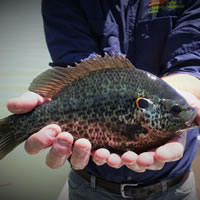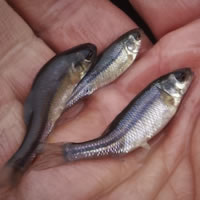![]() 830.992.0928
830.992.0928
 You Fish... We Handle the Rest!
You Fish... We Handle the Rest!
![]() 830.992.0928
830.992.0928
 You Fish... We Handle the Rest!
You Fish... We Handle the Rest!
We source our fish from many reputable fish farmers in Texas, Arkansas, Oklahoma and Missouri. Since we are not tied to one fish farm we are able to increase general fish availability, fish size availability and fish species availability.
We are first and foremost fisheries biologists and ecologists, not fish farmers. We understand fish stocking rates and corrective fish stocking procedures. Our stocking recommendations are not centered on pushing the largest quantity of fish, we focus on providing results and building long-term relationships with our clients. We do have some general fish stocking recommendations which we may start from, however, we ask the lake and pond owner the right questions to customize each fish stocking plan to their particular fishery goals. What questions should be asked?
Bluegill - The classic prey fish of any trophy bass lake. Bluegill can also be your main target fish for your lake; there is nothing like hooking a pound plus Bluegill on light tackle or a fly rod. Bluegill spawn multiple times when water temperatures are between 67-80° F. They are the perfect prey fish in Largemouth Bass lakes because they spawn prolifically. In most lakes, their average size is 6-10 inches, which makes them readily available to larger bass. They also have smaller mouths and do not compete with bass as heavily as others fish like Green Sunfish and Crappie. Adults mainly feed on insects, which makes them a perfect fish for connecting lower food web nutrients with your prized bass. The Texas State Record Bluegill is just over 2 Lbs.


Redear (Shell Cracker) – Shell Crackers are another prey fish stocked in bass lakes. They get the name Shell Cracker because they feed mainly on aquatic snails and other mollusks, which carry the Yellow Grub Trematode, which is a parasite that can be detrimental to your fish. Their preference for snails also helps connect lower food web nutrients with top end bass, similar to the connection that Bluegill provide to bass by their preference for insects. During their life, Redear hardly compete with bass. Redear grow larger than Bluegill with an average size of 8-11 inches. Their larger size fills an area that Bluegill cannot provide. The Texas state record is just under 3 Lbs. Redear make great table fare. They spawn 1-2 times a year between late spring and early summer. They rarely live more than 6 years.



Largemouth Bass – The most popular predator fish in the South, they can reach trophy size in small ponds and lakes with proper management. These fish tend to stunt at a length of 10-14” without proper management. Largemouth Bass spawn when temperatures reach 60-65° F. These fish are extreme predators, by the time they are 2-4” long they are already mainly consuming fish. The Texas state record is 18 Lbs. We can stock all strains of Largemouth Bass, which include northern/native Largemouth Bass, Florida Largemouth Bass, or Hybrid Largemouth Bass. There are advantages and disadvantages to each of these Largemouth Bass strains, call us to discuss your options.


Black Crappie – We get many requests for Crappie stocking. Black Crappie are a highly prized fish to many anglers, especially with light tackle. Crappie are known for their sweet, flaky white flesh. With all their great attributes, we only recommend stocking these fish in larger ponds over 5 acres. The reason we recommend only stocking Crappie in larger ponds is because they are prolific spawners and tend to overpopulate leading the population to a stunted Crappie condition, all fish under 5”. They also have large mouths and will compete directly with bass in many of their life stages. If Largemouth Bass are your main target stay clear of Black Crappie. Odds of successful Black Crappie stocking increase as the water body increases in size and habitat complexity. If you have an existing population of Black Crappie, management for Bass can be successful with active fishery management practices. To help concentrate Black Crappie and have higher success in crappie fishing add a few brush or timber piles. These habitat features tend to be preferred by crappie. Black Crappie live less then 7 years and spawn multiple times when water reaches 60° F. The Texas state record for Black Crappie is just less than 4 Lbs.


Channel Catfish – Channel Catfish are probably one of the most popular fish with lake owners that like to fill their frying pans with their catch. We recommend this catfish if you desire catfish in your bass lake because they provide lots of fun and attain a good size, but they do not attain the large size of the Blue Catfish. The Texas state record Channel Catfish is 36 Lbs, where the Texas state record Blue Catfish is 121 Lbs.. Channel Catfish generally live 6-7 years. Channel Catfish spawn when temperatures reach around 80° F. Generally Channel Catfish are stocked under the assumption that they will be a “Put-and-Take” fishery, meaning - you put in 100 Channel Catfish and catch 100 Channel Catfish; you then need to restock. Channel Catfish generally have low offspring survival in lakes with Largemouth Bass. Low offspring survival can also be attributed to lack of proper spawning habitat in small water bodies. If you do not want spawning, try to minimize cavity-forming habitat like hollow logs, coarse brush piles, tires, or undercut old creek banks.

Blue Catfish – These fish should be stocked in very large water bodies with varied habitat or in strictly cat-fishing pond or lakes. Blue Catfish can reach very large sizes, the Texas state record is 121 Lbs.. Generally you don't want Blue Catfish in your bass lake because of their higher growth potentials. They could target your prized 5+ LB Largemouth Bass. Blue Catfish spawn when temperatures reach 70-75° F.


Hybrid Striped Bass – Hybrid Striped Bass are a cross between White Bass and Striped Bass and are considered true Bass and are not related to Largemouth Bass. Hybrid Striped Bass are sometimes called Wipers or Palmetto Bass. These fish are usually stocked as a supplement to an existing Largemouth Bass/Bluegill lake. If stocked heavily they will compete greatly with your Largemouth Bass, however they are known to come to supplemental feed well and grow rather quickly on it. So if they are stocked with your Largemouth Bass supplemental feeding is a must to help reduce their need to compete with your Largemouth Bass for food. Hybrid Striped Bass can also be stocked alone in smaller ponds if a supplemental feeding program is in place. Hybrid Striped Bass are functionally sterile and are considered a “put and take” fishery, meaning- you put in 100 Hybrid Striped Bass and catch 100 Hybrid Striped Bass; you then need to restock. The Texas state record is 19 Lbs., however 5-7 Lbs. is common. Hybrid Striped Bass live around 5-6 years. Hybrid Striped Bass provide great cool weather fishing when your other fish become difficult to catch due to cooler temperatures.

Hybrid Bluegill – Hybrid Bluegill are most commonly a cross between a Bluegill and a Green Sunfish. This hybrid cross perfectly illustrates a natural phenomenon called “hybrid vigor”. Hybrid vigor in Hybrid Bluegill is shown in their accelerated growth rates and the fight they give on light fishing tackle. Hybrid Bluegill are not sterile, however, their reproduction is limited and offspring sex ratios tend to lean toward males, with few females, which also reduces reproduction. Hybrid Bluegill take supplemental feed readily and grow well on it. Hybrid Bluegill are a good option for smaller ponds with feeders.

Golden Shiner – A prey fish utilized by almost all other fish in your lake.
This fish is hardy and prolific. Golden Shiners spawn when temperatures reach 68-80° F.

Fathead Minnow – A prey fish utilized by almost all other fish in your lake. This fish is hardy and prolific. Fathead Minnows spawn when temperatures reach 60-65° F.



Tilapia Stocking - Since Tilapia are so prolific they can take foraging pressure off of your Bluegill and Redear population. If stocked at higher rates, Tilapia will also control filamentous algae. Tilapia will not survive water temperatures lower than 52º F, this means Tilapia survive into December. This does not mean your stocked Tilapia will all die at once; the Tilapia will become lethargic into winter and become easier prey for your bass. Rarely will you see large numbers of dead Tilapia.


Facts About Tilapia
How Will Tilapia Stocking Benefit Your Pond or Lake?
Rainbow Trout Stocking - You can stock Rainbow Trout for winter fishing recreation! We start stocking Rainbow Trout for our customers in early December. The trout must be fed supplemental feed by hand or by use of an automatic fish feeder. Trout provide a great fishery through the long, cold winter. The fish are excellent table fare. The trout should be caught by mid April because the spring water temperature rise will cause the demise of the remaining fish.


A Little History of Rainbow Trout in Texas
In the early 1930’s Judge JC Hunter stocked Rainbow Trout in McKittrick Creek in the Guadalupe Mountains, were they still exist from this original stocking.
In 1966 Rainbow Trout were stocked for public benefit in the tail-water downstream of Canyon Dam. Texas Parks and Wildlife stocked 286,799 individual Rainbow Trout in over 123 sites throughout the state in the 2009-2010 winters.
Triploid Grass Carp Stocking - Triploid Grass Carp are a non-reproductive exotic species, which can be stocked into Texas waters with an approved Grass Carp Permit Application from the Texas Parks and Wildlife Department. Triploid Grass Carp are herbivores and can be used as an additional tool to control excessive vegetation or algae. Vollmar Pond and Lake Management is a Texas Parks and Wildlife Department Exotic Species Permit holder and can be your source for Triploid Grass Carp in Texas. As a service to our customers we offer help in completing the technical part of the Texas Parks and Wildlife Department Grass Carp Permit Application. Just call, and with a few questions, we will have enough information to send you a partially complete Texas Parks and Wildlife Department Grass Carp Permit Application, sent to you as a printable document in your email. All you have to do is print it out and fill in the personal information and your Texas Parks and Wildlife Department Grass Carp Permit Application will be ready to submit.

